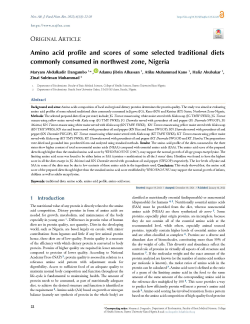Main Article Content
Amino acid profile and scores of some selected traditional diets commonly consumed in northwest zone, Nigeria
Abstract
Background and aims: Amino acids composition of local and regional dietary proteins determines the protein quality. The study was aimed at evaluating amino acid profiles of some selected traditional diets commonly consumed in Jigawa (JG), Kano (KN) and Katsina (KT) States, Northwest Zone-Nigeria. Methods: The selected prepared diets (four per state) include; JG Tuwon masara using white maize served with Kuka soup (JG TMW SWKS), JG Tuwon masara using yellow maize served with Kuka soup (JG TMY SWKS), JG Danwake served with groundnut oil and pepper (JG Danwake SWGOP), JG Moimoi, KN Tuwon masara using white maize served with Kuka soup (KN TMW SWKS), KN Tuwon masara using yellow maize served with Kuka soup (KN TMY SWKS), KN rice and beans served with groundnut oil and pepper (KN Rice and Beans SWGOP), KN Danwake served with groundnut oil and pepper (KN Danwake SWGOP), KT Tuwon masara using white maize served with Kuka soup (KT TMW SWKS), KT Tuwon masara using yellow maize served with Kuka soup (KT TMY SWKS), KT Danwake served with groundnut oil and pepper (KT Danwake SWGOP) and KT Dambu. The preparations were dried and grounded into powdered form and analyzed using standard methods. Results: The amino acid profile of the diets consumed in the three states show higher content of total non-essential amino acids (NEAA) compared with essential amino acids (EAA). The amino acid score of the prepared diets though higher than the standard amino acid score by WHO/FAO/UNU (2007), may support the normal growth of all age groups except lysine. The limiting amino acid score was found to be either lysine or SAA (cysteine + methionine) in all the 3 states’ diets. Histidine was found to have the highest score in all the diets except in JG Moimoi and KN Danwake served with groundnut oil and pepper (SWGOP) respectively. The low levels of lysine and SAA in some of the diets may be due to low contents of these amino acids in the ingredients used. Conclusion: This study showed that, the amino acid score of the prepared diets though higher than the standard amino acid score established by WHO/FAO/UNU may support the normal growth of infants, children as well as adults except lysine.







